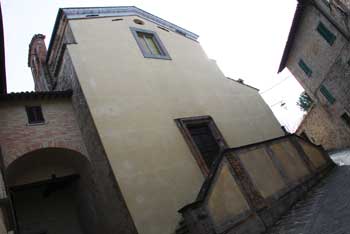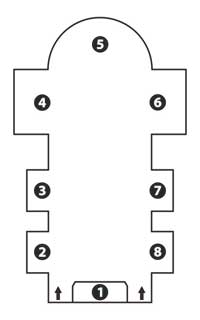
From existing documents in the historical archive, we can say that the building of the “Collegiata” (collegiate church) traces back to the 1300.
Ruled by a Chapter of Canons, the church was promoted to cathedral with the building of a throne and an Episcopalian desk. The definitive arrangement was reached with the restoration works under Canon Pazzaglia in 1661.

The Collegiata is a basilica with a Latin cross basement which ends with a circular apse on whose walls, above the chorus, there is a fresco by Giovanni Parenti with the Twelve Apostles represented in adoration (first half of the 1700). In the middle of this fresco we can find a flight of clouds with the descent of the Holy Spirit. There also a cloth representing St. Gregorius Magnus in the act of writing the “Dialogues” under the look of the Virgin on the throne with Christ Child in her womb.
Inside the left arm of the SS. Rosario Chapel’s altar stands the cloth by Chialli from Città di Castello which represents the Virgin of the Rosary with Child between the saints Domenico and Francis. In the middle of the chapel there is a dome with the Four Evangelists painted on it.
 An outstanding coffered ceiling in carved and golden wood stands above the central nave. Four episodes of the life of the Virgin Mary are represented between the moulding and the ceiling. An inscription on the compass dates “1817”. A cloth representing the “Last Supper” was transferred in the Collegiata from the Church of Santa Croce: this painting was commissioned by the Marquise Geronima Bandini Calves to Dionigi Calvaert in 1611 and it can be now admired in the Chapel of the SS. Rosario. Above an altar, on the right side there is a small picture representing the Virgin belonging to the XIV century Sienese school. Then, there is the statue of S. Rocco attributed to the sculptor Romano Alberti (1502-1568) from Sansepolcro (AR) and a great cloth representing Santa Albertina from Montone can be seen before the exit. Finally, the carved walnut sacristy is particularly remarkable.
An outstanding coffered ceiling in carved and golden wood stands above the central nave. Four episodes of the life of the Virgin Mary are represented between the moulding and the ceiling. An inscription on the compass dates “1817”. A cloth representing the “Last Supper” was transferred in the Collegiata from the Church of Santa Croce: this painting was commissioned by the Marquise Geronima Bandini Calves to Dionigi Calvaert in 1611 and it can be now admired in the Chapel of the SS. Rosario. Above an altar, on the right side there is a small picture representing the Virgin belonging to the XIV century Sienese school. Then, there is the statue of S. Rocco attributed to the sculptor Romano Alberti (1502-1568) from Sansepolcro (AR) and a great cloth representing Santa Albertina from Montone can be seen before the exit. Finally, the carved walnut sacristy is particularly remarkable.